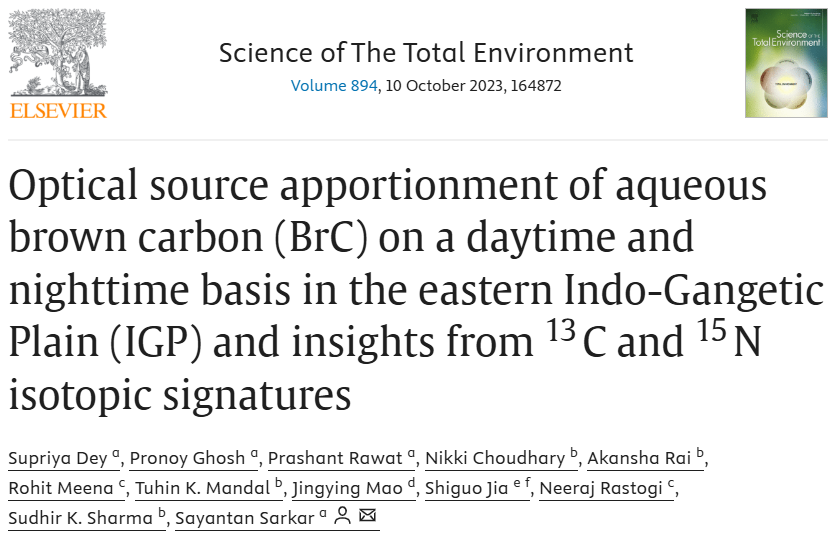
Optical source apportionment of aqueous brown carbon (BrC) on a daytime and nighttime basis in the eastern Indo-Gangetic Plain (IGP) and insights from 13C and 15N isotopic signatures
Science of The Total Environment
Supriya Dey, Pronoy Ghosh, Prashant Rawat, NIKKI CHOUDHARY, Akansha Rai, Rohit Meena, Tuhin K Mandal., Jingying Mao, Shiguo Jia, Neeraj Rastogi, Sudhir K Sharma., & Sayantan Sarkar
2023-10-10
This study reports day-night and seasonal variations of aqueous brown carbon (BrCaq) and constituent humic-like substances (HULIS) (neutral and acidic HULIS: HULIS-n and HULIS-a) from the eastern Indo-Gangetic Plain (IGP) of India during 2019–2020. This is followed by the application of the receptor model positive matrix factorization (PMF) for optical source apportionment of BrCaq and the use of stable isotopic ratios (δ13C and δ15N) to understand atmospheric processing. Nighttime BrCaq absorption and mass absorption efficiencies (MAE) were enhanced by 40–150 % and 50–190 %, respectively, compared to the daytime across seasons, possibly as a combined effect from daytime photobleaching, dark-phase secondary formation, and increased nighttime emissions. MAE250 nm/MAE365 nm (i.e., E2/E3) ratios and Angstrom Exponents revealed that BrCaq and HULIS-n were relatively more aromatic and conjugated during the biomass burning-dominated periods while BrCaq and HULIS-a were comprised mostly of non-conjugated aliphatic structures from secondary processes during the photochemistry-dominated summer. The relative radiative forcing of BrCaq with respect to elemental carbon (EC) was 10–12 % in the post-monsoon and winter in the 300–400 nm range. Optical source apportionment using PMF revealed that BrCaq absorption at 300, 365 and 420 nm wavelengths in the eastern IGP is mostly from biomass burning (60–75 %), followed by combined marine and fossil fuel-derived sources (24–31 %), and secondary processes (up to 10 %). Source-specific MAEs at 365 nm were estimated to be the highest for the combined marine and fossil fuel source (1.34 m2 g−1) followed by biomass burning (0.78 m2 g−1) and secondary processing (0.13 m2 g−1). Finally, δ13C and δ15N isotopic analysis confirmed the importance of summertime photochemistry and wintertime NO3−-dominated chemistry in constraining BrC characteristics. Overall, the quantitative apportionment of BrCaq sources and processing reported here can be expected to lead to targeted source-specific measurements and a better understanding of BrC climate forcing in the future.
- Optical source apportionment of diurnal BrCaq carried out using PMF.
- MAE of BrCaq increased by 50–190 % during nighttime compared to daytime.
- Biomass burning (BB) was the major source of BrCaq (60–75 %) in the eastern IGP.
- Source-specific MAE for marine and fossil fuel emission was twice that of BB.
- δ13C and δ15N signatures provided insights into the atmospheric processing of BrCaq.

